The Dutch Golden Age, spanning roughly the 17th century, was a period of extraordinary artistic flourishing in the Netherlands. While masters like Rembrandt van Rijn and Johannes Vermeer explored portraiture, genre scenes, and interior views, another significant current flowed through Dutch art: landscape painting. Within this genre, a distinct group of artists emerged, known as the Dutch Italianates, who looked south to Italy for inspiration. Among the most accomplished and distinctive of these painters was Adam Pynacker.
Adam Pynacker (c. 1620 – 1673) carved a unique niche for himself with his evocative depictions of the Italian countryside, bathed in a characteristic silvery light. Though firmly rooted in the Dutch tradition of detailed observation, his work is imbued with a romanticism and idealized beauty drawn from his experiences south of the Alps. His life and art reflect the cross-cultural currents of the era, and his paintings remain captivating examples of the Dutch fascination with the Italian landscape.
From Wine Merchant to Painter: Early Life and the Italian Sojourn
Adam Pynacker was born in Schiedam, a town near Rotterdam in the Netherlands, sometime between late January 1620 and early January 1621. He came from a prosperous background; his father, Christiaen Pynacker, was a successful wine merchant who also served as a member of the Schiedam city council. His mother, Maria Graswinckel, hailed from the nearby city of Delft, a major artistic center. It seems Pynacker was initially expected to follow in his father's footsteps, and indeed, he was involved in the wine trade in his early years.
However, the allure of art proved stronger than commerce. At some point, likely in the early 1640s, Pynacker decided to pursue a career as a painter. A pivotal moment in his artistic development was his journey to Italy, undertaken around 1645. He spent approximately three years abroad, immersing himself in the Italian landscape and artistic traditions. This extended period was crucial, shaping his thematic focus and stylistic approach for the rest of his career.
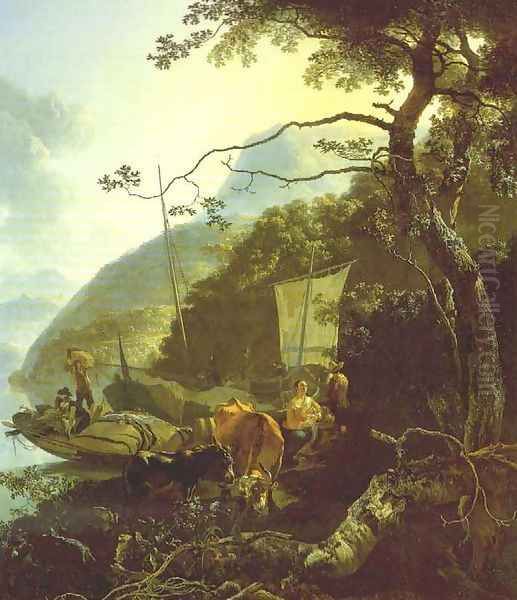
The experience of Italy was transformative for many Northern European artists. The dramatic scenery, ancient ruins, and, perhaps most importantly, the quality of the Mediterranean light offered a stark contrast to the flatter, often more muted landscapes of the Netherlands. Pynacker, like fellow Dutch Italianates such as Jan Both and Jan Asselijn before him, absorbed these influences deeply. His time in Italy provided him with a rich repertoire of motifs – rolling hills, classical architecture, rustic figures, and specific flora – that would populate his canvases upon his return.
The Italianate Vision: Style, Light, and Subject Matter
Pynacker is best known as a leading exponent of the Dutch Italianate style. This style is characterized by its depiction of Italian or Italian-inspired landscapes, often idealized and imbued with a pastoral or Arcadian atmosphere. Unlike Dutch painters who focused meticulously on the local scenery, such as Jacob van Ruisdael or Meindert Hobbema, the Italianates sought a more romanticized vision, frequently employing warm, golden, or, in Pynacker's case, distinctively cool, silvery light.
Pynacker's handling of light is perhaps his most recognizable trait. He particularly excelled at capturing the effects of late afternoon or early evening sun, often referred to as ' Hesperian light'. This light rakes across the landscape, highlighting textures and creating long shadows, lending his scenes a tranquil, sometimes melancholic, beauty. His palette often features a unique silvery or cool tonality, differentiating him from the warmer palettes of artists like Jan Both or Nicolaes Berchem. This cool light illuminates details with remarkable clarity.
His subject matter consistently revolves around the Italian landscape, particularly evoking the Campagna region around Rome. His paintings often feature motifs like rustic bridges, crumbling ruins, waterfalls, and winding paths through wooded areas. He paid meticulous attention to the rendering of nature, especially trees and foliage. His depiction of birch trees, with their silvery bark, is particularly noteworthy and complements his characteristic light effects. Figures – shepherds, travellers, boatmen – are usually present but remain relatively small, serving to animate the scene and enhance the sense of scale rather than being the primary focus.
Pynacker's technique involved careful, often delicate brushwork, allowing for the precise rendering of details like leaves, rocks, and water. While many of his works are relatively small cabinet paintings, demonstrating exquisite craftsmanship, he also undertook commissions for larger, decorative landscape series designed to adorn the interiors of wealthy patrons' homes. This practice was somewhat less common for landscape specialists at the time and points to his reputation and the desirability of his work among affluent Dutch collectors.
Signature Works and Where to Find Them
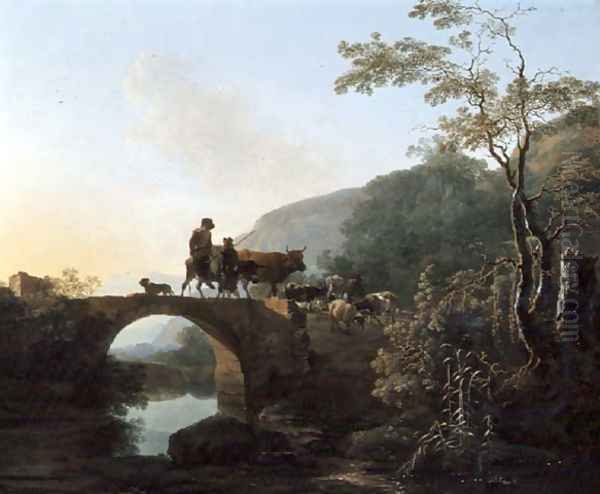
Several key works exemplify Adam Pynacker's style and artistic concerns. These paintings are now housed in major museum collections around the world, testament to his enduring appeal.
_Boatmen Moored on the Shore of an Italian Lake_ (c. 1650-1670, Rijksmuseum, Amsterdam): This iconic painting showcases many Pynacker hallmarks. The tranquil lake scene is bathed in his signature cool, silvery light, illuminating the detailed foliage on the bank and the figures tending to their boat. The composition leads the eye gently into the distance, creating a sense of peaceful expanse typical of his idealized Italian views.
_Bridge in an Italian Landscape_ (Date unknown, collection details vary but often cited as a prime example): This work, frequently discussed for its blend of heroic and pastoral themes, likely features a prominent stone bridge arching over a river or ravine, set within a lush, mountainous landscape. Pynacker often used bridges as strong compositional elements. The low viewpoint and dramatic lighting, possibly depicting twilight, would enhance the grandeur and romanticism of the scene, typical of his approach to elevating landscape.
_Wooded Landscape with Travelers_ (late 1640s, National Gallery of Art, Washington D.C.): Probably painted shortly after his return from Italy, this work displays his early mastery of the Italianate style. It features travellers resting or moving through a dense, sun-dappled woodland. The detailed rendering of the trees and undergrowth, combined with the play of light and shadow, creates a rich, immersive atmosphere.
_A View with an Arch_ (1654, National Museum of Wales, Cardiff): Dated works like this help track his development. The arch, likely a ruin or part of an aqueduct, provides a classical framing device common in Italianate landscapes. It would frame a view into a deeper landscape, demonstrating Pynacker's skill in creating spatial recession and integrating architectural elements naturally into the scenery.
_A Sailing Ship Moored on a Lake Shore_ (c. 1660): Similar in theme to the Rijksmuseum's painting, this work would again emphasize the tranquil beauty of an Italian lakeside setting. The depiction of the sailing ship and the reflections in the water would showcase his ability to render different textures and the effects of light on water, all within his characteristic cool palette.
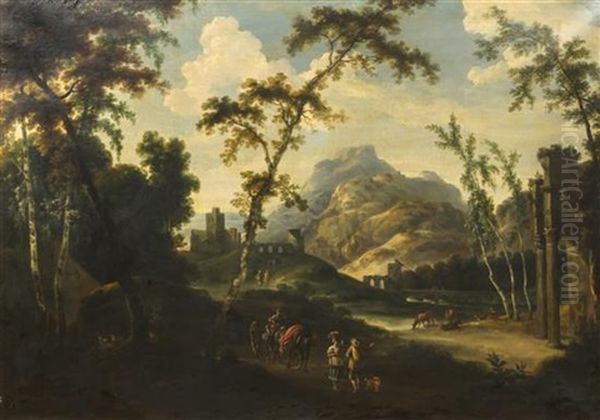
These paintings, along with others held in institutions like the Dulwich Picture Gallery in London and numerous private collections, demonstrate Pynacker's consistent vision and technical refinement throughout his career. They reflect the Dutch appetite for idealized foreign landscapes that offered an escape from their familiar surroundings.
Career in the Netherlands: Delft, Amsterdam, and Personal Life
After his formative years in Italy, Pynacker returned to the Netherlands around 1648 or 1649. He initially seems to have settled in Delft, his mother's hometown and a vibrant artistic hub, famously home to Johannes Vermeer. Records show Pynacker had connections in Delft between 1649 and 1651. One notable contact was Adam Pick, a painter but also an innkeeper and wine merchant. While there's no evidence Pick directly influenced Pynacker's style, he may have offered practical support or connections as Pynacker established his artistic career, perhaps bridging Pynacker's old life in the wine trade with his new one in art.
Later, Pynacker moved to Amsterdam, the bustling economic and cultural heart of the Dutch Republic. He appears to have been active there from the late 1650s until his death. In 1658, he married Eva Maria de Geest in Schiedam. Notably, Eva Maria was Catholic, and Pynacker subsequently converted to Catholicism. Their two children were baptized in the Catholic faith. This conversion is an interesting biographical detail in the predominantly Protestant Dutch Republic, perhaps reflecting personal conviction or the social circles he moved in through his wife's family.
Pynacker continued to paint his signature Italianate landscapes throughout his time in Delft and Amsterdam. His works found favour with Dutch collectors who appreciated the combination of fine detail, evocative light, and exotic scenery. His decision to sometimes work on a large scale for decorative schemes suggests he achieved considerable success and recognition during his lifetime. He remained active as a painter until his death in Amsterdam in March 1673.
Artistic Circle, Influence, and Teaching
While Pynacker developed a highly personal style, he operated within a network of contemporary artists. He was clearly influenced by the first generation of Dutch Italianates, particularly Jan Both and Jan Asselijn, whose works he would have known and likely admired. Their approaches to composition and light certainly provided a foundation for his own explorations. Some art historians also suggest possible influence from Herman Saftleven, another landscape painter active in Utrecht.
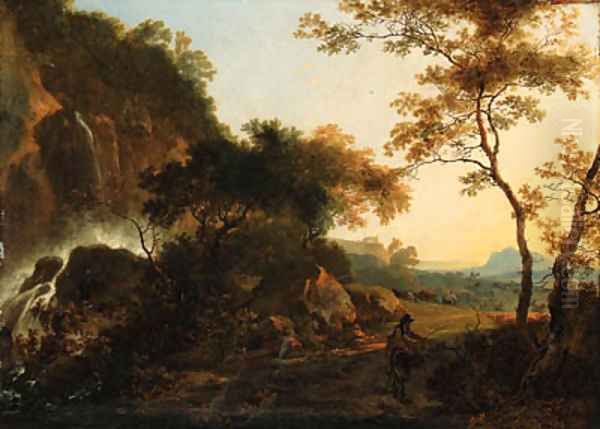
Unlike some major artists who ran large workshops, Pynacker's teaching activities seem to have been more limited, but he did have pupils. Gijsbert Verhoek is mentioned as one of his students. Another significant disciple was Jan Gabrielsz Sonnenschein, who clearly inherited Pynacker's style, continuing to produce Italianate landscapes in a similar vein. The existence of these students indicates Pynacker's reputation was sufficient to attract followers eager to learn his specific techniques and approach.
Pynacker worked during a period of incredible artistic diversity in the Netherlands. While he focused on idealized Italian scenes, other contemporaries like Rembrandt were revolutionizing portraiture and history painting, Vermeer was perfecting his luminous interiors, and specialists like Willem Kalf excelled in still life. Pynacker's circle also included fellow Italianate painters active in Amsterdam and other cities, such as Nicolaes Berchem and Karel Dujardin, who explored similar themes but often with warmer palettes or a greater emphasis on figures and animals. Earlier figures like Pieter van Laer (known as 'Bamboccio'), who specialized in Roman street scenes, had also paved the way for Dutch interest in Italian subjects. Pynacker's specific contribution was his unique handling of cool light and his detailed, almost poetic rendering of Italian nature.
Reception Through Time: Appreciation and Criticism
Adam Pynacker's work enjoyed popularity during his lifetime and in the decades immediately following his death, particularly among collectors who favoured the Italianate style. His paintings were appreciated for their technical skill, decorative qualities, and the pleasing, idealized vision of Italy they presented. His ability to capture the nuances of light and atmosphere was particularly admired.
However, the Italianate style itself faced criticism, both during the 17th century and later. Some Dutch critics and artists felt that the focus on foreign landscapes represented a departure from, or even a betrayal of, the authentic Dutch tradition of depicting their own country. The idealized, sometimes artificial-seeming beauty of Italianate scenes was contrasted unfavourably with the perceived realism and sobriety of native Dutch landscape painting. Pynacker's style, with its distinctive, sometimes stylized rendering of light and foliage, was occasionally singled out in these critiques, sometimes labelled as "decadent" or "un-Dutch" by later commentators looking back with a more nationalistic lens.
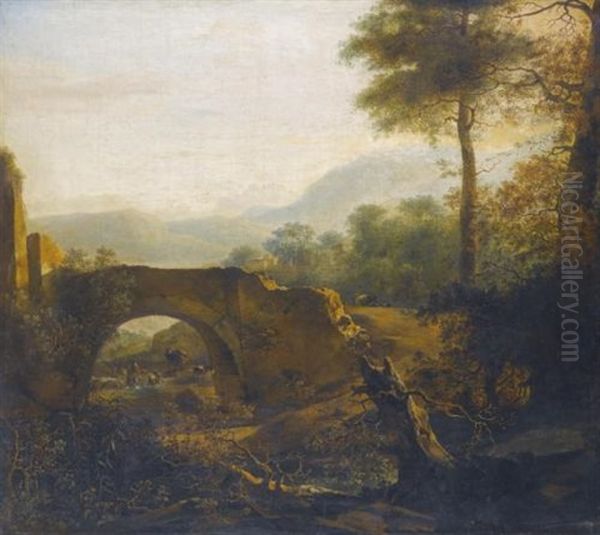
Despite these periodic criticisms, Pynacker's reputation as a significant figure within the Dutch Golden Age has endured. Art historians recognize him as one of the most original and technically gifted of the second generation of Dutch Italianate painters. His unique interpretation of light and landscape distinguishes his work clearly from his contemporaries. His innovation in creating large-scale decorative landscape cycles also marks him as an artist responsive to the demands of the art market of his time.
Modern scholarship continues to appreciate Pynacker's artistry. His works are studied for their technique, their place within the broader context of European landscape painting (showing affinities with artists like Claude Lorrain in their idealization of nature), and their reflection of Dutch cultural attitudes towards Italy. While perhaps not as universally famous as Rembrandt or Vermeer, Adam Pynacker holds a secure and respected position in the history of art.
An Enduring Legacy of Light and Landscape
Adam Pynacker stands as a fascinating figure in Dutch art history. Emerging from a merchant background, he dedicated his life to capturing the beauty of a land far from his own, translating the light and landscape of Italy into a uniquely Dutch idiom. His paintings are characterized by their distinctive cool, silvery light, meticulous attention to natural detail, and a pervasive sense of tranquility and idealized beauty.
His journey to Italy was the defining experience of his artistic life, providing the inspiration and motifs that would dominate his oeuvre. Upon returning to the Netherlands, he refined his vision, creating works that appealed to the tastes of Dutch collectors while maintaining a highly personal style. He navigated the artistic currents of Delft and Amsterdam, influenced figures like Jan Both and Jan Asselijn, and passed on his skills to students like Gijsbert Verhoek and Jan Gabrielsz Sonnenschein.
Though his Italianate style sometimes drew criticism for being "un-Dutch," Pynacker's mastery of light, composition, and detail secured his reputation. His ability to evoke the atmosphere of the Italian countryside, filtered through his unique artistic sensibility, continues to captivate viewers today. His paintings remain important testaments to the Dutch Golden Age's engagement with the wider world and the enduring allure of the Italian landscape, rendered unforgettable by his brush. Adam Pynacker was, and remains, a true master of light and landscape.